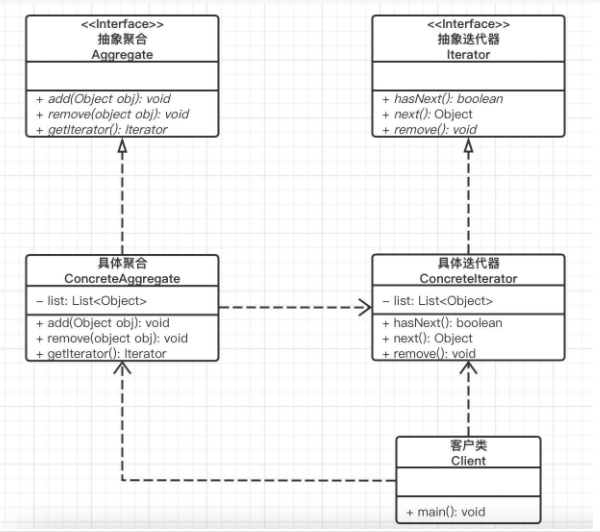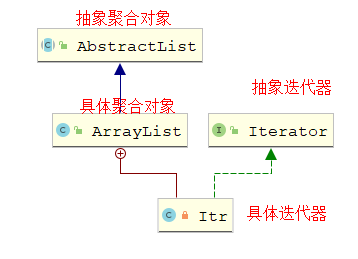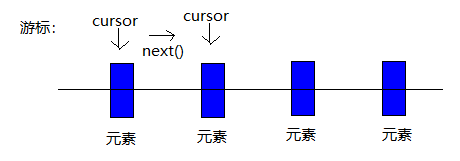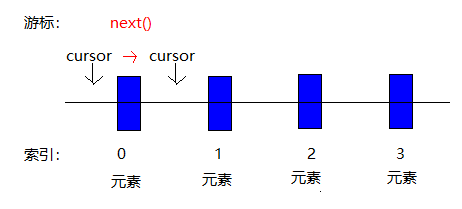summary
Continue with the previous chapter: Daily class - handwritten ArrayList - Generic , this article will talk about the implementation details of the iterator of ArrayList. Due to space constraints, this article first implements the one-way iterative method iterator(), and the two-way iterative listIterator() will be implemented in the next article.
Iterator mode
Talking about iterator() Before ListIterator(), let's popularize the iterator pattern.
Baidu Encyclopedia gives an introduction: Iterator mode provides a method to sequentially access various elements in an aggregate object (set / array) without exposing the internal representation of the object.
Class diagram

Participation role
Iterator: iterator interface, which defines iterator operation rules. Generally, there are three core methods,
1> Hasnext() determines whether it can be iterated 2> Next () performs an iteration and returns the current element 3> Remove() deletes the iteration to the element
ConcreteIterator: iterator interface implementation class, which implements three methods of interface iteration.
Aggregate: Abstract aggregate object, a collection object that holds data. Iterators traverse the providers of elements, either abstract classes or interfaces. For example: List interface or AbstractList abstract class.
ConcreteAggregate: the implementation of the abstract aggregate object interface (abstract class), which calls the iterator to traverse the elements one by one.
Take JDK as an example:

Iterator iterator
To implement the iterator() method, the above iterator pattern structure should be established:
MyIterator
/**
* Iterator interface: defining iteration rules
*/
public interface MyIterator<E> {
/**
* Judge whether there is a next element (judge whether it can be iterated)
* @return
*/
boolean hasNext();
/**
* Get current iteration to element (execute next iteration element)
* @return
*/
E next();
/**
* Deletes the element to which the current iteration is applied
*/
void remove();
}
The MyIterator interface defines the rules of iterators. There are at least three core methods of iterators: hasNext, next and remove.
Operation diagram

When next() is executed, cursor will automatically move down
Note: there is another way to understand:

The cursor is located in front of the first element. Each time you move it, you skip one element. Personally, I think there is no difference in operation.
MyItr
It is defined inside the MyArrayList class and is not exposed
public class MyArrayList<E> {
/**
* MyArrayList Class internal definition private internal class MyItr
* Objective: to implement the iterator corresponding to hidden MyArrayList
* MyArrayList The iterative interface can be exposed mainly through the iterator method.
*/
private class MyItr implements MyIterator<E>{
//Cursor (index) starts at 0
private int cursor;
@Override
public boolean hasNext() {
//As long as you don't iterate to the end, you can iterate all the time
return cursor != size;
}
@Override
public E next() {
//During iteration, if the cursor exceeds the total number, an error is reported
if (cursor >= size)
throw new NoSuchElementException();
//++Indicates that next is the next element
return (E) elementData[cursor++];
}
@Override
public void remove() {
//In the above, if the remove operation is called immediately without executing next first, it will prompt illegal operation
if (cursor < 1){
throw new IllegalStateException("Please execute first next method");
}
//The cursor is still within the operational range
if(cursor <= size){
//After the next method, the cursor executes with the next element. If you want to delete, delete the current element
//The cursor returns to the previous value
MyArrayList.this.remove(cursor -1);
//After deletion, the size-1 in the collection and the right should also be synchronized with - 1
cursor--;
}
}
}
}Define the iterator method in the MyArrayList class and provide the operation object of the iterator for iteration
public class MyArrayList<E> {
.....
/**
* Expose iterator methods for manipulating collection iterators
* Note that interface polymorphism is used here to effectively hide the implementation details of MyItr private inner class
* @return
*/
public MyIterator<E> iterator(){
return new MyItr();
}
....
}Iterative testing
public class App{
public static void main(String[] args) {
MyArrayList<String> list = new MyArrayList<>();
list.add("a");
list.add("b");
list.add("c");
list.add("d");
MyIterator<String> iterator = list.iterator();
while (iterator.hasNext()){
System.out.println(list);
iterator.next();
iterator.remove();
System.out.println(list);
}
}
}To print well, override the toString method
public String toString() {
MyIterator<E> it = iterator();
if (! it.hasNext()){
return "[]";
}
StringBuilder sb = new StringBuilder();
sb.append('[');
for (;;) {
E e = it.next();
sb.append(e);
if (! it.hasNext()){
return sb.append(']').toString();
}
sb.append(',').append(' ');
}
}[a, b, c, d] [b, c, d] [b, c, d] [c, d] [c, d] [d] [d] []
At this point, the iterator function of the MyArrayList class is implemented.